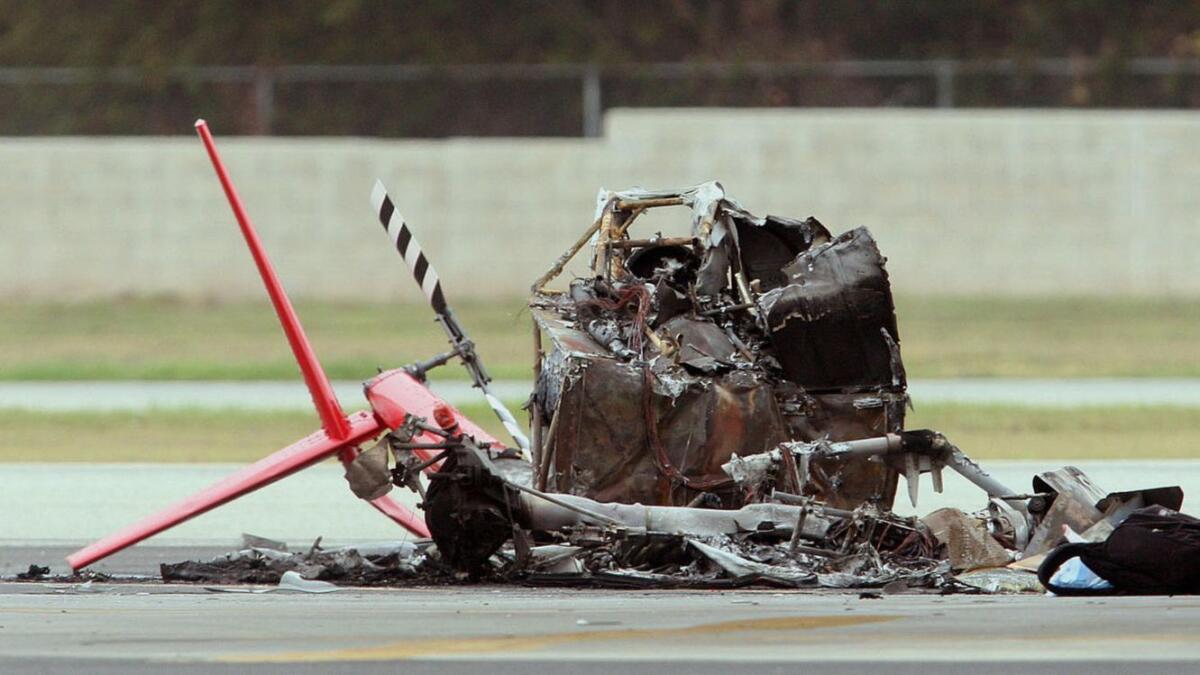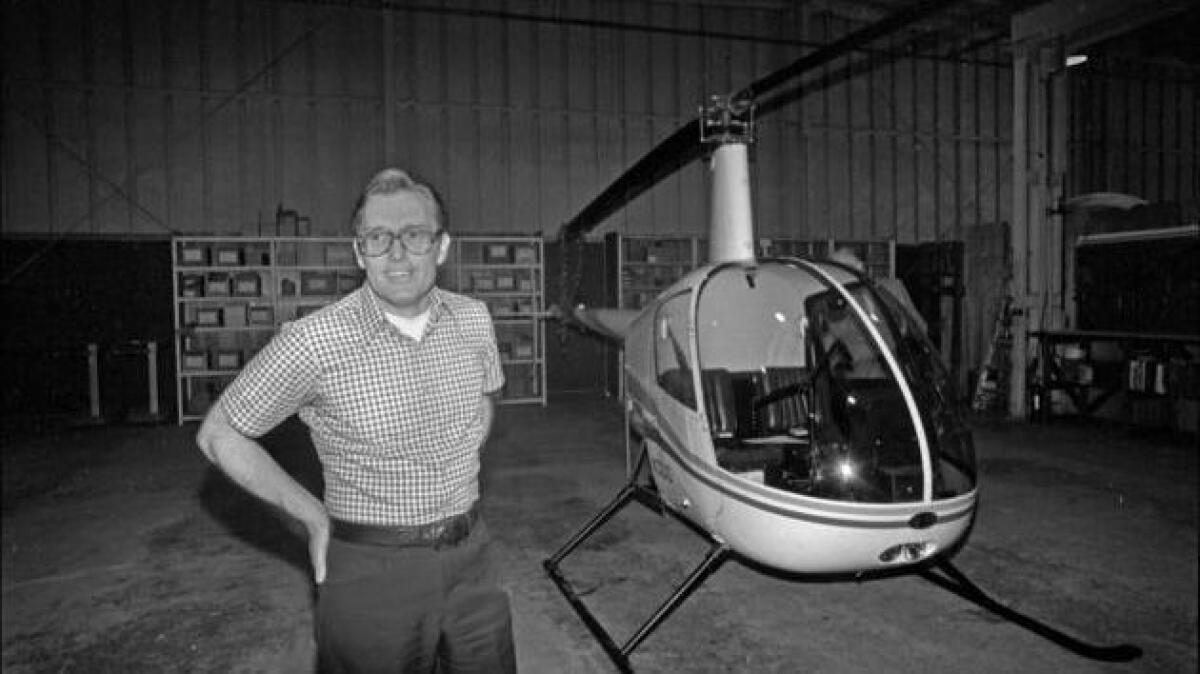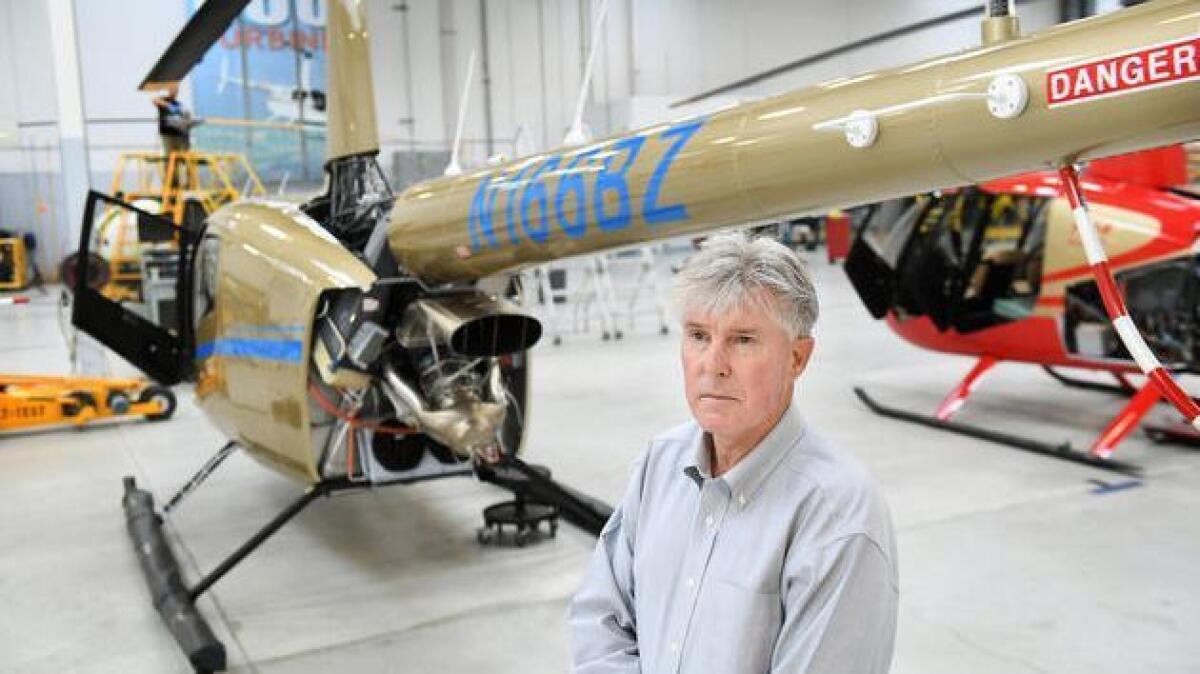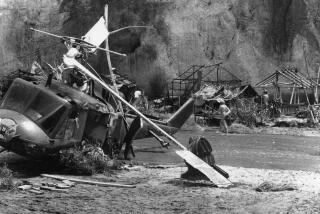Danger spins from the sky: The world’s best-selling helicopter has a deadly history of crashes
- Share via

The flight lasted all of a minute.
The four-seat helicopter had barely lifted off from John Wayne Airport when it nosed down, clipped two houses and slammed into a third, killing the pilot and two of his three passengers.
“It was like a train hitting a wall,” said Paddi Faubion, who saw the Jan. 30 crash from her balcony in a gated Newport Beach neighborhood.
The cause has yet to be determined, but the type of helicopter is well known to accident investigators: the Robinson R44. It is the world’s best-selling civilian helicopter, a top choice among flight schools, sightseeing companies, police departments and recreational pilots.
It also is exceptionally deadly.
Robinson R44s were involved in 42 fatal crashes in the U.S. from 2006 to 2016, more than any other civilian helicopter, according to a Times analysis of National Transportation Safety Board accident reports.
That translates to 1.6 deadly accidents per 100,000 hours flown — a rate nearly 50% higher than any other of the dozen most common civilian models whose flight hours are tracked by the Federal Aviation Administration.
Family-owned Robinson Helicopter Co. disputed The Times’ analysis, contending that the FAA undercounts the flight hours for the R44, leading to an inflated accident rate. The company vigorously defended its record, maintaining that its aircraft are safe and reliable when flown within their operating limits.
Still, safety issues have dogged the Torrance manufacturer over its 45-year history, The Times found, and both the company and the FAA have been slow to address design features and operating characteristics that have caused or contributed to accidents.
Scores of R44 pilots and passengers have been killed in preventable post-crash fires, or in helicopters that dropped from the sky when they suddenly lost lift. Others have died when main rotor blades peeled apart in flight or sliced through tail booms or cockpits.
Some pilots or their surviving family members said they were stunned to learn — after accidents — of the R44’s safety issues, and they questioned why regulators had not taken stronger action.
Gail Bechler, whose husband, Jim, died in a fiery 2012 accident that investigators concluded was his fault, said she was shocked to find out that his R44’s fuel tanks had “split like a Coke can” in a relatively low-impact crash — and that there had been many others like it.
“I thought, wait a minute, they can continue to make this same part even after they knew? I just remember thinking, ‘Who is going to die next?’ ” she said. “Those helicopters should have all been grounded and there should have been a giant red flag and a recall.”

More than 600 people have perished in Robinson crashes around the world since 1982. At least 65 wrongful-death and product liability lawsuits have been filed across the country since then, accusing Robinson of concealing or willfully ignoring safety issues and dodging accountability — allegations the company denies. Many of the lawsuits were resolved with confidential settlements.
The company president, Kurt Robinson, contested his helicopter’s place atop The Times’ accident-rate ranking. He said the FAA flight-hour totals used to calculate the accident rate are a “guesstimate.”
The FAA rejected that claim. The agency’s estimates, published each year by a group of professional statisticians and currently available through 2016, are based on a survey sent to operators in the field. Federal aviation officials routinely use the data to calculate accident rates.
Even using the company’s estimated flight hours — nearly 40% more than the FAA’s — the R44 still had the highest rate at 1.17 fatal accidents per 100,000 flight hours.
Robinson noted that U.S. fatal R44 crashes declined to two in 2017, which he said reflected the company’s efforts to reduce the accident rate. He also argued that the vast majority of Robinson accidents are the fault of pilots — not the machine — and that many are students or hobbyists with little time at the controls.
“When people say that ours have more accidents than the others, well, ours are not being flown by professional people,” Robinson said. “Ours are being flown much, much more at the entry point of the market.”
A helicopter for the masses
The company was born in 1973 in the Rancho Palos Verdes home of engineer Frank Robinson, who became enamored of helicopters as a kid in Washington state.
“When I was 9 or 10 I saw a picture in the Seattle newspaper of Igor Sikorsky hovering in a VS-300 prototype,” Robinson said in a 2010 lecture at the Royal Aeronautical Society in England. “Right then and there I decided that’s what I want to do.”
He earned a degree in mechanical engineering and then spent 16 years working for aircraft manufacturers, including major helicopter makers Bell and Hughes. Neither was making the helicopter for the masses that he envisioned.
“I wanted to design a very simple — with an emphasis on simple — low-cost helicopter that could be produced efficiently and sold to the public at a price that many people could afford,” Robinson said in his lecture.
He replaced his living room furniture with drafting tables, set up a workshop in the garage and farmed out parts fabrication to a business partner in Hawaii. He built a prototype of the two-seat, piston-engine R22 in a hangar at nearby Torrance Airport, now home to the company’s 600,000-square-foot factory.


The R22 hit the market in 1979. With a bargain price tag of $40,000, it soon became the most popular civilian helicopter in the world and a favorite of flight schools.
Developed from the R22, the R44 made its debut in 1993 and is now the company’s most popular model, largely because it can carry more passengers.
Today the R44 sells for about $475,000, the R22 for about $300,000 and the R66 — a five-seat turbine-powered model introduced in 2010 — for about $900,000. In all, Robinson has made more than 12,000 helicopters, with at least 60% of recent sales going to foreign buyers.
“They put people in the air who otherwise would not be able to afford to fly helicopters or buy helicopters,” said Ilyas Akbari, a Los Angeles aviation attorney whose firm has brought about a dozen lawsuits alleging that design defects make Robinsons unforgiving of pilot mistakes and inherently unsafe.
“It is such a double-edged sword with this company,” Akbari said. “It is a glaring problem, but nobody wants to fix it.”
Unique rotor design
Whether the lightweight design of Robinson helicopters makes them dangerous has long been the subject of debate — and litigation.
Helicopters generally share a basic design: A main rotor system attached to a vertical drive shaft, or mast, provides the lift and thrust. A tail rotor stabilizes the aircraft.
But those systems vary, and Robinson uses its own version of a two-bladed main rotor that teeters on a hub atop the mast.
All teetering rotor systems are susceptible to a phenomenon called mast-bumping, which occurs when the seesawing becomes so extreme that the hub or the inner ends of the rotor blades strike the mast.
Mast-bumping often occurs in low-gravity — or “low G” — conditions, which can be induced by incorrect pilot inputs or turbulent weather.
In some helicopters, it might cause only minor damage. In Robinsons, it has been catastrophic: Rotor systems break off or the blades cut into cockpits or tail booms, according to aviation experts and incident reports by U.S. and foreign accident investigators.
“Due to their unique main rotor design, during a sudden and prolonged or severe low-G condition Robinson helicopters can roll rapidly to the right and likely break up before a pilot can recover,” New Zealand government accident investigators said in a 2016 report on a fatal R44 mast-bumping.
From 1981 through early 1992, about two dozen R22s were involved in fatal U.S. crashes linked to a loss of control. Many bore signs of mast-bumping, but exact causes could not be determined because there were no survivors or onboard data recorders.
Then on June 29, 1992, near Richmond, Calif., another R22 broke up, killing the pilot and his flight student.
This time was different: The student was carrying a cassette recorder to capture her flight lesson on tape, which revealed no warning of trouble. The helicopter broke apart in midair so suddenly it interrupted the pilot in midsentence. As the helicopter plunged toward San Pablo Bay, the recorder also picked up the student’s muffled cry of “Help!”
The NTSB blamed the accident on an “undetermined event” and launched an extensive review of fatal Robinson crashes — 31 in the R22 and three in the then-fledgling R44. It ruled out common mechanical issues, such as engine failure or fuel system problems, but did not come up with an explanation for the sudden loss of control.
In early 1995, the NTSB asked the FAA to ground Robinson helicopters to allow for further research and testing. The FAA responded by issuing Special Flight Aviation Regulation 73, which requires extra instruction about mast-bumping risks and low-G conditions, along with specific flight checks for pilots of the R22 and R44.
No other make of helicopter is subject to such a regulation, according to the FAA.
“I have felt it was a good thing, a mandated type of training that prevented accidents,” said Kurt Robinson, who took over the company from his father in 2010.
The new rule’s impact is unclear. The causes of many helicopter crashes remain a mystery even after the NTSB — tasked with scrutinizing every U.S. civil aviation accident — finishes its job.
The Times reviewed all investigation reports issued since the new regulation took effect and identified 10 fatal Robinson crashes in which investigators saw signs of mast-bumping.
In 2016, the government of New Zealand placed Robinson mast-bumping on its “watch list” of most serious transportation safety concerns, citing 14 fatal accidents over the previous 20 years.
Several government agencies there have since banned the use of Robinsons by their employees.
The company protested the watch-list designation and said mast-bumping accidents are “entirely avoidable” when pilots use good judgment and follow operating procedures. Kurt Robinson rejected any link between mast-bumping and design.
“There is absolutely nothing to do with our hub or rotor system that affects or causes it,” he said.
He said that some New Zealand pilots had been practicing maneuvers known as cyclic pushovers, which can cause mast-bumping and are prohibited by Robinson operator handbooks. The company has helped retrain Kiwi pilots, he said.
“People who like adventure are attracted to our products,” he said. “But there’s also a limit. You have to instruct them and tell them there are things you can’t do.”
A question of experience
Robinson’s contention that its pilots are less experienced is borne out to some extent by The Times’ analysis.
Though the federal government does not track the flight hours of pilots across the board, it does log the experience level of those involved in accidents. Robinson pilots in deadly crashes had tallied a median of 1,017 flight hours, the least of any major helicopter maker.
At the same time, reports by the NTSB detail examples of experienced pilots who were killed in what the agency said should have been survivable accidents.
Take the case of Jim Bechler, an Orange County attorney who had piloted Robinson helicopters for more than 30 years and bought a new R44 in 2008. He was flying home from a business meeting near Temecula when he stopped to refuel at Corona Municipal Airport.
Minutes later, as the helicopter lifted off with 40 gallons of fuel in its tanks, its rotor blades clipped a metal canopy over the fuel island. The R44 flailed briefly, dropped a few feet to the pavement and burst into flames.
Bechler burned to death. He was 61.
The NTSB blamed the November 2012 accident on his failure to clear the overhang. But the safety board also said he “most likely would have survived” if no fire had occurred. His family settled out of court with the company.

Safety board records detail many such low-impact R44 crashes in which dozens of occupants died or suffered serious burns when the all-aluminum fuel tanks — which sit behind the cabin — exploded in otherwise survivable accidents.
In July 2006, Robinson addressed the issue not by fortifying its tanks, but by trying to fireproof pilots and passengers.
“To reduce the risk of injury in a post-crash fire, it is strongly recommended that a fire-retardant Nomex flight suit, gloves and hood or helmet be worn by all occupants,” said Robinson Safety Notice 40.
The warning was deemed impractical by many pilots and widely ignored. A year after it was issued, four people burned to death in a low-impact crash in Washington state. None were wearing fire-resistant gear.
In 2009, the company began to bolster its new R44 tanks with flexible bladders, which are puncture-resistant and designed to contain fuel in low-impact crashes. A year later, it offered them as a voluntary retrofit for helicopters already in service — at owners’ expense of about $6,800 for parts, plus labor.
Kurt Robinson said it took until 2009 to develop a suitable bladder for his helicopters, disputing allegations in wrongful-death lawsuits that the company could have acted sooner.
“It’s one thing to sit on the sideline and say, ‘You’ve got to improve that,’ ” Robinson said. “It’s another thing, from an engineering standpoint, to say, ‘How are you going to do this?’ This is not a simple thing to do.”
Robinson said some R44s with all-aluminum tanks continue to fly, despite his company’s best efforts to urge owners to retrofit them.
‘Nothing in my training prepared me’
Larry Wells, a pilot for the FAA, was practicing hovering, landing and liftoff maneuvers near Jackson, Miss., on Sept. 1, 2009, when his Robinson R44 began to shudder violently.
“When the vibration started, I looked in to check the gauges, but by that time the vibration was so bad I could not read them,” Wells recalled.
At 1,000 feet above the ground, everything was a blur as he fought to regain control. Seconds later, the helicopter tore through the treetops and slammed into a house, killing his passenger, Charles Farmer, a 59-year-old co-worker.
Wells, then 57, broke more than 60 bones and spent six weeks in a coma. His left arm was partly paralyzed and he now walks with a limp.
The NTSB ruled the crash was caused by “the pilot’s failure to maintain adequate main rotor rpm, for undetermined reasons.” Wells contends the accident was not his fault and might have been averted if Robinson had divulged what it had known for 16 years about a phenomenon known as mast-rocking, or chug.
The company had documented the sort of severe vibrations that Wells experienced in a once-confidential analysis referred to in court records as the “Robinson chug report.” Dated Jan. 13, 2007, it was written by chief engineer Pete Riedl and detailed incidents of R44 mast-rocking from 1993 to 2006, attributing it to a fore-and-aft movement of the main rotor shaft and gearbox assembly.
Instead of sharing the report with pilots, owners or the FAA, the company argued in legal proceedings that it contained proprietary information. It eventually surfaced in a lawsuit stemming from the deaths of two Canadian men whose new R44 broke up in flight near Desert Center, Calif.
“Nobody had ever mentioned to me in any safety course, no Robinson helicopter pilot, no communique, no nothing had ever mentioned to me a vibration problem with the R44,” Wells testified in a deposition.
He sued Robinson, which disputed that mast-rocking caused his crash. In July 2015, a federal jury in Mississippi awarded Wells $2.8 million for his injuries and economic damages, along with $700,000 to Farmer’s widow. Before jurors began deliberations on punitive damages, the two sides reached a confidential settlement.
In an interview, Kurt Robinson described the vibration as a “red herring” that was more of an annoyance than a safety issue and said the company addressed it years ago by changing to firmer rubber gearbox mounts.
“I will tell you I’ve never seen anybody hurt with that,” he said.
The NTSB cited other mast-rocking accidents, including a 2009 hard landing in which three Alaska state troopers walked away from their heavily damaged R44. They were in the air for 90 seconds when it shook “to the point where I felt that the aircraft was about to come apart,” pilot Scott Quist told the NTSB.
“Nothing in my training prepared me for this condition,” he told investigators.
The NTSB concluded that mast-rocking was the cause of Quist’s accident and took Robinson to task for not sounding alarms about the potential danger.
“As a result, not all operators are familiar with the phenomenon, as the accident operator was not,” the agency noted.
The safety board closed its file on mast-rocking but did not declare the issue resolved. In 2013, the board expressed concern that the company had never found the root cause of the problem and thus could not ensure that it would not recur.
“They haven’t figured it out,” former NTSB chairman Christopher Hart told The Times late last year.
Robinson said that doesn’t matter, because the stiffer mounts have eliminated the problem: “We knew how to solve it and we did.”
A rash of Robinson accidents
Robinson participates in NTSB investigations involving its helicopters and submits its findings to federal authorities.
It does not analyze its findings to determine accident causes. Nor does it retain detailed records of accidents or incidents, compile statistical data to track recurring issues or tally how many people have been killed or injured in its helicopters.
That lack of historical data is troubling to aviation safety experts.
“When the answer is, ‘We don’t keep databases because every time something goes wrong we fix it,’ that doesn’t answer the question of just what is the story, what is going on here?” said Hart, the former NTSB chairman. “Without data, you are at a loss. You are shooting in the dark.”
Aviation consultant William Lawrence, a retired Marine Corps colonel and helicopter test pilot and instructor who has testified as a paid expert against Robinson Helicopter Co. in a dozen lawsuits, contends the company willfully ignores safety issues to avoid liability.
“In my near half-century of aviation experience, RHC is the only aircraft manufacturer I have found in the world that does not focus on safety,” he wrote in a report filed with a lawsuit stemming from a New Jersey crash. “I believe RHC divests itself of all records in an attempt to have ‘plausible deniability’ related to responsibility.”
Kurt Robinson dismissed such criticism and said victims’ lawyers often are merely seeking big payouts. He said the company keeps accident reports and other records for “only as long as the FAA requires us to” and that throwing them away does not impede its commitment to safety.
“We look at every accident trying to rack our brains out and say what improvements can we make to the helicopter, what things can we tell pilots through safety notices that will enhance safety for them,” he said.
In Southern California, three R44s have crashed since January 2017, killing three people and injuring six others, NTSB records show. The safety board has not determined causes for those accidents, which remain under investigation.
The helicopter that crashed in Newport Beach in January, killing the pilot and two passengers, was operated by a flight school and touring company and was headed to Catalina Island.
Six months earlier, an R44 on a sightseeing flight lost power and landed hard on a city street in Sherman Oaks, injuring the pilot and two passengers.
And two months before that, an R44 suddenly lost power and crashed on a golf course maintenance yard in Santa Barbara, seriously injuring the pilot and two passengers, a young couple on a sightseeing tour. All escaped just before fire destroyed the helicopter.
“I was very happy when they emerged alive,” said golfer Kevin Keating, who saw the R44 fall from the sky. “Oh, man, were they lucky.”
https://twitter.com/kchristensenLAT
More to Read
Inside the business of entertainment
The Wide Shot brings you news, analysis and insights on everything from streaming wars to production — and what it all means for the future.
You may occasionally receive promotional content from the Los Angeles Times.











